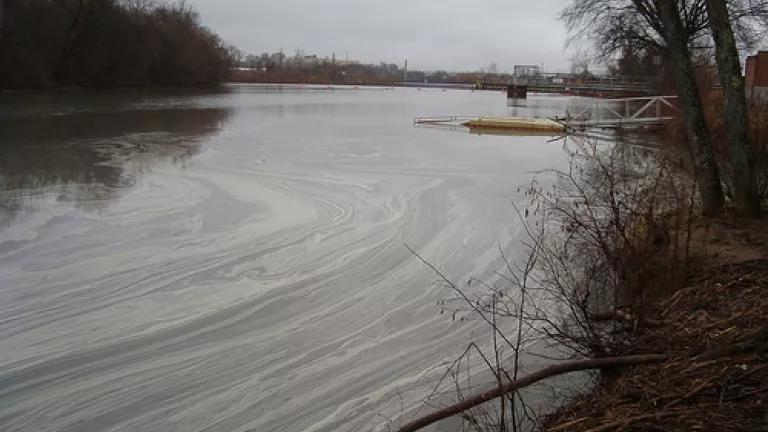
photo credit: Dan River coal ash pollution courtesy of Appalachian Voices
EPA has announced that the two primary encapsulated uses of coal ash are safe, so recyclers have no legitimate remaining arguments to support their previous requests for a weak coal ash rule.
One of the big issues propagated by the coal burning utility industry is that regulating coal ash waste as a hazardous waste would hurt the market for recycling of coal ash. Even some in the environmental community believe that if something is hazardous as a waste, it would be hazardous in a product. This sounds logical but happens not always to be the case. There is a reason waste can be much more harmful than the same chemical in a product: It is the same as chemotherapy drugs; important and safe when used correctly, but toxic when they are no longer used, so disposal must be done carefully.
The key to the safe use of coal ash is encapsulation. Encapsulation is the technology that is used at EPA-regulated hazardous waste landfills to make sure that if the toxic waste gets wet, which it does, it is bound at the molecular level into an insoluble compound that will not allow the toxics elements to leach to contaminate underground water sources or surface waters.
This is the same technology used in encapsulating fly ash and FGD sludge in concrete and wallboard. Therefore, it was not a surprise to me that EPA found that the use of fly ash in concrete and wallboard is no more a threat than the raw materials it replaces. Even if coal ash used in construction is demolished, it still will not leach toxics, because even if pulverized, it is not broken down below the molecular level.
The EPA study, released February 7, 2014 is entitled "Methodology for Evaluating Encapsulated Beneficial Uses of Coal Combustion Residuals" and an accompanying document, "Coal Combustion Residual Beneficial Use Evaluation: Fly Ash Concrete and [flue gas desulfurization (FGD) Gypsum Wallboard," applies the new methodology to those practices.
The risk evaluation document concludes that "environmental releases of constituents of potential concern (COPC) from CCR fly ash concrete and FGD gypsum wallboard during use by the consumer are comparable to or lower than those from analogous non-CCR products, or are at or below relevant regulatory and health-based benchmarks for human and ecological receptors."
“Based on the conclusion of the analysis in this document stated above, and the available environmental and economic benefits, EPA supports the beneficial use of coal fly ash in concrete and FGD gypsum in wallboard."
NRDC, as well as the Green Building Council, agrees that recycled fly ash in building materials is superior to alternatives. Regulating the disposal of fly ash should raise the price of disposal and therefore encourage more companies to recycle fly ash. Such reuse will protect our air and water and lower greenhouse emissions by lowering the carbon inputs into cement.
The coal ash recyclers should support EPA’s regulation of coal ash disposal instead of continuing down the road with the utilities. The utilities are very happy with the present weak standards which, not surprisingly, led to the recent spill in North Carolina in the Dan River. It is time these companies spent their money upgrading their facilities rather than lobbying Congress to keep Americans at risk from their unsafe practices.
